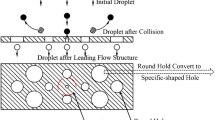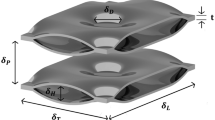Abstract
In this study, to examine the effects of the changes in the inlet and outlet pipe diameters and exit channel width on the performance of a welded plate heat exchanger, a CFD (Computational Fluid Dynamics) analysis of the welded plate heat exchanger was carried out while changing the Rp-ch (ratio between the cross-section area of pipe and channel) and Rf-e (ratio between the end width of exit and front width of channel). The realizable k–ε model with the non-equilibrium wall function was used. As a result, the heat exchange performance decreased slightly, but the pressure drop decreased significantly by a decrease in Rp − ch and an increase in Rf − e. In addition, the results of this study confirmed that a change in Rp − ch affects the pressure drop of inlet and outlet manifolds significantly, and a change in Rf − e affects the pressure drop of the channel and outlet manifold significantly.















Similar content being viewed by others
Abbreviations
- A:
-
Area [m2]
- b:
-
Chevron wave amplitude[mm]
- cp :
-
Specific heat [kJ/kg∙K]
- Dp :
-
Pipe diameter [mm]
- k:
-
Heat transfer and pressure drop [W/m∙K]
- Lch :
-
Length of the channel [mm]
- Lp :
-
Length of the plate [mm]
- m:
-
Mass flow rate [kg/s]
- Nu:
-
Chamber volume [m3]
- Q:
-
Heat transfer capacity (kW)
- Rp-ch :
-
Ratio between the cross-section area of pipe and channel
- Rf-e :
-
Ratio between the end width of exit and front width of channel
- Re:
-
Reynolds number
- P:
-
Pressure [kPa]
- PHE :
-
Plat heat exchanger
- px :
-
Chevron pitch [mm]
- T:
-
Plate thickness [mm]
- ΔTlm :
-
Logarithmic mean temperature difference [K]
- Pr:
-
Prandtl number
- U:
-
Overall heat transfer coefficient [kW/m2∙K]
- u:
-
Viscosity [Pa∙s]
- T:
-
Temperature [K]
- Wch :
-
Length of the channel [mm]
- Wch,e :
-
End width of the channel [mm]
- Wch,f :
-
Front width of the channel [mm]
- Wh :
-
Width of the plate [mm]
- β:
-
Chevron angle [°]
- ρ:
-
Density [kg/m3]
- μ:
-
Coefficient of viscosity [Nㆍs/ m2]
- c:
-
Cold side
- h:
-
Hot side
- in:
-
Inlet
- mani:
-
Manifold
- o:
-
Outlet
- tot:
-
Total
References
Khan TS, Khan MS, Chyu MC, Ayub ZH (2010) Experimental investigation of single phase convective heat transfer coefficient in a corrugated plate heat exchanger for multiple plate configurations. Appl Therm Eng 30(8–9):1058–1065
Nilpueng K, Keawkamrop T, Ahn HS, Wongwises S (2018) Effect of chevron angle and surface roughness on thermal performance of single- phase water flow inside a plate heat exchanger. International Communications in Heat and Mass Transfer 91:201–209
Wajs J, Mikielewicz D (2016) Influence of metallic porous microlayer on pressure drop and heat transfer of stainless steel plate heat exchanger. Appl Therm Eng 93:1337–1346
Sarraf K, Launay S, Tadrist L (2015) Complex 3D-flow analysis and corrugation angle effect in plate heat exchangers. Int J Therm Sci 94:126–138
Zhang Y, Jiang C, Yang Z, Zhang Y, Bai B (2016) Numerical study on heat transfer enhancement in capsule-type plate heat exchangers. Appl Therm Eng 108:1237–1242
Li XW, Meng JA, Li ZX (2010) An experimental study of the flow and heat transfer between enhanced heat transfer plates for PHEs. Exp Thermal Fluid Sci 34(8):1194–1204
Piper M, Olenberg A, Tran JM, Kenig EY (2015) Determination of the geometric design parameters of pillow-plate heat exchangers. Appl Therm Eng 91:1168–1175
Mitrovic J, Maletic B (2011) Numerical simulation of fluid flow and heat transfer in thermoplates. Chem Eng Technol 34(9):1439–1448
Xie S, Liang Z, Zhang L, Wang Y (2018) A numerical study on heat transfer enhancement and flow structure in enhanced tube with cross ellipsoidal dimples. Int J Heat Mass Transf 125:434–444
Gherasim I, Galanis N, Nguyen CT (2011) Effects of smooth longitudinal passages and port configuration on the flow and thermal fields in a plate heat exchanger. Appl Therm Eng 31(17–18):4113–4124
Jin S, Hrnjak P (2017) Effect of end plates on heat transfer of plate heat exchanger. Int J Heat Mass Transf 108:740–748
Mota FA, Ravagnani MA, Carvalho EP (2014) Optimal design of plate heat exchangers. Appl Therm Eng 63(1):33–39
Raja BD, Jhala RL, Patel V (2018) Thermal-hydraulic opti- mization of plate heat exchanger: a multi-objective approach. Int J Therm Sci 124:522–535
Hajabdollahi H, Naderi M, Adimi S (2016) A comparative study on the shell and tube and gasket-plate heat exchangers: the economic viewpoint. Appl Therm Eng 92:271–282
Arsenyeva OP, Tovazhnyanskyy LL, Kapustenko PO, Khavin GL, Yuzbashyan AP, Arsenyev PY (2016) Two types of welded plate heat exchangers for efficient heat recovery in industry. Appl Therm Eng 105:763–773
Peric M (2004) Flow simulation using control volumes of arbitrary polyhedral shape. ERCOFTAC bulletin 62:25–29
Spiegel M, Redel T, Zhang YJ, Struffert T, Hornegger J, Grossman RG, Karmonik C (2011) Tetrahedral vs. polyhedral mesh size evaluation on flow velocity and wall shear stress for cerebral hemodynamic simulation. Computer methods in biomechanics and biomedical engineering 14(01):9–22
Jain S, Joshi A, Bansal PK (2007) A new approach to numerical simulation of small sized plate heat exchangers with chevron plates. J Heat Transf 129(3):291–297
Tsai YC, Liu FB, Shen PT (2009) Investigations of the pressure drop and flow distribution in a chevron-type plate heat exchanger. International communications in heat and mass transfer 36(6):574–578
Hu Z, He X, Ye L, Yang M, Qin G (2017) Full-scale research on heat transfer and pressure drop of high flux plate heat exchanger. Appl Therm Eng 118:585–592
Wang CC, Yang KS, Tsai JS, Chen Y (2011a) Characteristics of flow distribution in compact parallel flow heat exchangers, part I: typical inlet header. Appl Therm Eng 31(16):3226–3234
Wang CC, Yang KS, Tsai JS, Chen Y (2011b) Characteristics of flow distribution in compact parallel flow heat exchangers, part II: modified inlet header. Appl Therm Eng 31(16):3235–3242
Bassiouny MK, Martin H (1984a) Flow distribution and pressure drop in plate heat exchangers-I, U-type arrangement. Chem Eng Sci 39(4):693–700
Bassiouny MK, Martin H (1984b) Flow distribution and pressure drop in plate heat exchangers-II, Z-type arrangement. Chem Eng Sci 39(4):701–704
Tong JC, Sparrow EM, Abraham JP (2009) Geometric strategies for attainment of identical outflows through all of the exit ports of a distribution manifold in a manifold system. Appl Therm Eng 29(17–18):3552–3560
Acknowledgements
This work was supported by “Human Resources Program in Energy Technology” of the Korea Institute of Energy Technology Evaluation and Planning (KETEP), granted financial resource from the Ministry of Trade, Industry & Energy, Republic of Korea (No. 20194030202410) and the Ministry of Trade, Industry & Energy (MOTIE) of the Republic of Korea (20172010105410).
Author information
Authors and Affiliations
Corresponding author
Additional information
Publisher’s note
Springer Nature remains neutral with regard to jurisdictional claims in published maps and institutional affiliations.
Rights and permissions
About this article
Cite this article
Ham, J., Shin, Y. & Cho, H. Theoretical investigation of the influence of pipe diameter and exit channel width in welded plate heat exchanger on heat exchanger performance. Heat Mass Transfer 56, 759–771 (2020). https://doi.org/10.1007/s00231-019-02733-8
Received:
Accepted:
Published:
Issue Date:
DOI: https://doi.org/10.1007/s00231-019-02733-8




